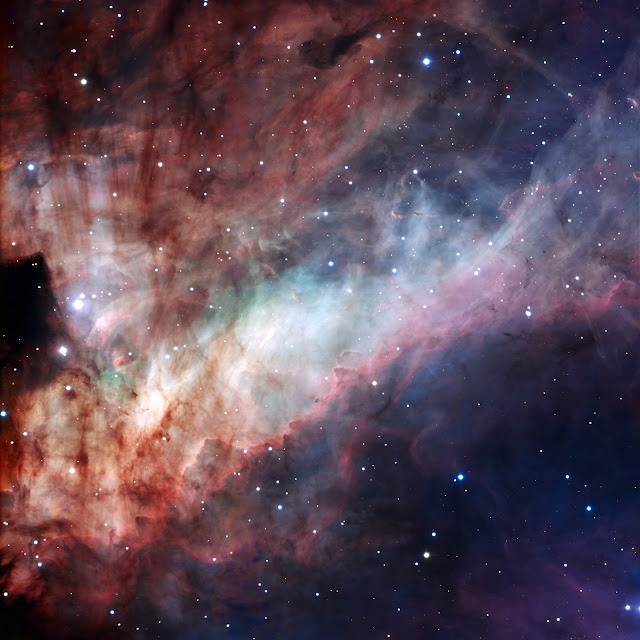The Omega Nebula, sometimes called the Swan Nebula, is a dazzling stellar nursery located about 5500 light-years away towards the constellation of Sagittarius (the Archer). An active star-forming region of gas and dust about 15 light-years across, the nebula has recently spawned a cluster of massive, hot stars. The intense light and strong winds from these hulking infants have carved remarkable filigree structures in the gas and dust.
When seen through a small telescope the nebula has a shape that reminds some observers of the final letter of the Greek alphabet, omega, while others see a swan with its distinctive long, curved neck. Yet other nicknames for this evocative cosmic landmark include the Horseshoe and the Lobster Nebula.
Swiss astronomer Jean-Philippe Loys de Chéseaux discovered the nebula around 1745. The French comet hunter Charles Messier independently rediscovered it about twenty years later and included it as number 17 in his famous catalogue. In a small telescope, the Omega Nebula appears as an enigmatic ghostly bar of light set against the star fields of the Milky Way. Early observers were unsure whether this curiosity was really a cloud of gas or a remote cluster of stars too faint to be resolved. In 1866, William Huggins settled the debate when he confirmed the Omega Nebula to be a cloud of glowing gas, through the use of a new instrument, the astronomical spectrograph.
In recent years, astronomers have discovered that the Omega Nebula is one of the youngest and most massive star-forming regions in the Milky Way. Active star-birth started a few million years ago and continues through today. The brightly shining gas shown in this picture is just a blister erupting from the side of a much larger dark cloud of molecular gas. The dust that is so prominent in this picture comes from the remains of massive hot stars that have ended their brief lives and ejected material back into space, as well as the cosmic detritus from which future suns form.
The released image, obtained with the EMMI instrument attached to the ESO 3.58-metre New Technology Telescope (NTT) at La Silla, Chile, shows the central region of the Omega Nebula in exquisite detail. In 2000, another instrument on the NTT, called SOFI, captured another striking image of the nebula in the near-infrared, giving astronomers a penetrating view through the obscuring dust, and clearly showing many previously hidden stars. The NASA/ESA Hubble Space Telescope has also imaged small parts of this nebula (heic0305a and heic0206d) in fine detail.
At the left of the image a huge and strangely box-shaped cloud of dust covers the glowing gas. The fascinating palette of subtle colour shades across the image comes from the presence of different gases (mostly hydrogen, but also oxygen, nitrogen and sulphur) that are glowing under the fierce ultraviolet light radiated by the hot young stars.
Image Credit: ESO
Explanation from: https://www.eso.org/public/news/eso0925/




Splendourous Cosmos 🌌
ReplyDeleteSplendourous Cosmos 🌌
ReplyDelete